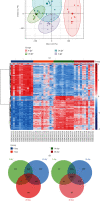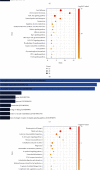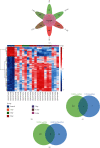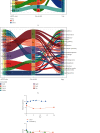Identification of miRNA Regulatory Networks and Candidate Markers for Fracture Healing in Mice
- PMID: 34840596
- PMCID: PMC8611357
- DOI: 10.1155/2021/2866475
Identification of miRNA Regulatory Networks and Candidate Markers for Fracture Healing in Mice
Abstract
Background: It is important to improve the understanding of the fracture healing process at the molecular levels, then to discover potential miRNA regulatory mechanisms and candidate markers.
Methods: Expression profiles of mRNA and miRNA were obtained from the Gene Expression Omnibus database. We performed differential analysis, enrichment analysis, protein-protein interaction (PPI) network analysis. The miRNA-mRNA network analysis was also performed.
Results: We identified 499 differentially expressed mRNAs (DEmRs) that were upregulated and 534 downregulated DEmRs during fracture healing. They were mainly enriched in collagen fibril organization and immune response. Using the PPI network, we screened 10 hub genes that were upregulated and 10 hub genes downregulated with the largest connectivity. We further constructed the miRNA regulatory network for hub genes and identified 13 differentially expressed miRNAs (DEmiRs) regulators. Cd19 and Col6a1 were identified as key candidate mRNAs with the largest fold change, and their DEmiR regulators were key candidate regulators.
Conclusion: Cd19 and Col6a1 might serve as candidate markers for fracture healing in subsequent studies. Their expression is regulated by miRNAs and is involved in collagen fibril organization and immune responses.
Copyright © 2021 Xianglu Li et al.
Conflict of interest statement
The authors declare that they have no conflict of interest.
Figures





Similar articles
-
Identification of potential miRNA-mRNA regulatory network contributing to pathogenesis of HBV-related HCC.J Transl Med. 2019 Jan 3;17(1):7. doi: 10.1186/s12967-018-1761-7. J Transl Med. 2019. PMID: 30602391 Free PMC article.
-
Identification of Transcriptional Markers and microRNA-mRNA Regulatory Networks in Colon Cancer by Integrative Analysis of mRNA and microRNA Expression Profiles in Colon Tumor Stroma.Cells. 2019 Sep 8;8(9):1054. doi: 10.3390/cells8091054. Cells. 2019. PMID: 31500382 Free PMC article.
-
Construction of the circRNA-miRNA-mRNA Regulatory Network of an Abdominal Aortic Aneurysm to Explore Its Potential Pathogenesis.Dis Markers. 2021 Nov 5;2021:9916881. doi: 10.1155/2021/9916881. eCollection 2021. Dis Markers. 2021. PMID: 34777635 Free PMC article.
-
Identifying the key genes and microRNAs in colorectal cancer liver metastasis by bioinformatics analysis and in vitro experiments.Oncol Rep. 2019 Jan;41(1):279-291. doi: 10.3892/or.2018.6840. Epub 2018 Nov 1. Oncol Rep. 2019. PMID: 30542696 Free PMC article.
-
Exploring the molecular mechanisms of osteosarcoma by the integrated analysis of mRNAs and miRNA microarrays.Int J Mol Med. 2018 Jul;42(1):21-30. doi: 10.3892/ijmm.2018.3594. Epub 2018 Mar 27. Int J Mol Med. 2018. PMID: 29620143 Free PMC article.
Cited by
-
Identification of the miRNAome in human fracture callus and nonunion tissues.J Orthop Translat. 2023 Mar 1;39:113-123. doi: 10.1016/j.jot.2023.01.005. eCollection 2023 Mar. J Orthop Translat. 2023. PMID: 36909863 Free PMC article.
-
Identification of the miRNA-mRNA regulatory network in a mouse model of early fracture.Front Genet. 2024 Jun 11;15:1408404. doi: 10.3389/fgene.2024.1408404. eCollection 2024. Front Genet. 2024. PMID: 38919952 Free PMC article.
-
Construction of dynamic ceRNA regulatory networks in osteogenesis during fracture healing based on transcriptomic analysis.Sci Rep. 2025 Jul 24;15(1):26946. doi: 10.1038/s41598-025-12505-6. Sci Rep. 2025. PMID: 40707643 Free PMC article.
-
Downregulation of miR-221-3p by LncRNA TUG1 Promoting the Healing of Closed Tibial Fractures in Mice.Biomed Res Int. 2022 Aug 26;2022:1624446. doi: 10.1155/2022/1624446. eCollection 2022. Biomed Res Int. 2022. Retraction in: Biomed Res Int. 2024 Feb 12;2024:9823060. doi: 10.1155/2024/9823060. PMID: 36060124 Free PMC article. Retracted.
-
Research progress and potential application of microRNA and other non-coding RNAs in forensic medicine.Int J Legal Med. 2024 Mar;138(2):329-350. doi: 10.1007/s00414-023-03091-1. Epub 2023 Sep 28. Int J Legal Med. 2024. PMID: 37770641 Review.
References
MeSH terms
Substances
LinkOut - more resources
Full Text Sources

